| Article ID | Journal | Published Year | Pages | File Type |
|---|---|---|---|---|
| 7320445 | Neuropsychologia | 2015 | 9 Pages |
Abstract
The development of language hemispheric specialization is not well understood in young children, especially regarding expressive language functions. In this study, we investigated age-related changes in expressive language lateralization patterns in a population of children (3-6 and 7-10 years old), adolescents (11-16 years old), and young adults (19-30 years old). During functional near-infrared spectroscopy recordings, all participants performed a verbal fluency task, which consisted in naming as many words as possible belonging to a given semantic category. Hemoglobin concentration changes were measured in bilateral frontal and temporal cortical areas. During the language task, results showed a strong left hemisphere response along with weaker right hemisphere activation in all groups. Age-related increases in hemodynamic responses were found bilaterally, with younger children showing smaller hemodynamic responses than adolescents and adults in both hemispheres. Overall, these findings confirm that a left hemisphere specialization is already established in young children and persists through adulthood. Early left hemisphere specialization for expressive language suggests that language development hinges on structural and functional properties of the human brain with little reorganization occurring with development.
Related Topics
Life Sciences
Neuroscience
Behavioral Neuroscience
Authors
Natacha Paquette, Maryse Lassonde, Phetsamone Vannasing, Julie Tremblay, Berta González-Frankenberger, Olivia Florea, Renée Béland, Franco Lepore, Anne Gallagher,
